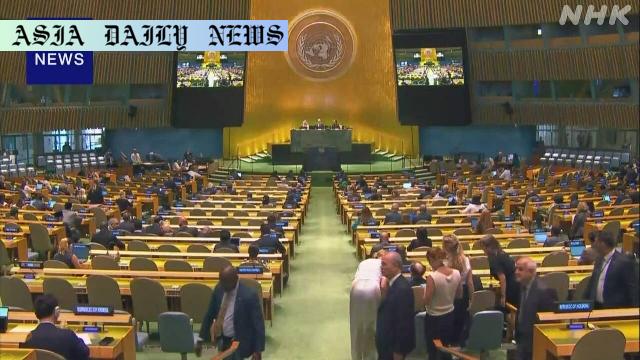Two-state solution at heart of UN document urging Hamas to disarm, Israeli settlements to halt, and Gaza unification with West Bank.

Tackling the Israel-Palestine Conflict Through a Two-State Solution
The recent UN conference on the Israel-Palestine conflict has reignited global attention on the need for a peaceful and sustainable resolution. The central theme of the conference, hosted in New York and co-led by France and Saudi Arabia, was the endorsement of the ‘two-state solution’ – a concept that advocates the coexistence of an independent Palestinian state alongside Israel. The conference culminated in the release of the New York Declaration, which outlines specific measures aimed at resolving key sticking points in this long-standing dispute.
Among the most significant recommendations is the call for Hamas, the Islamist group currently governing Gaza, to disarm and hand over control of Gaza to the Palestinian Authority. The document emphasizes the importance of unifying Gaza with the West Bank, a step deemed vital for the formation of a cohesive Palestinian state. It also demands an immediate halt to Israeli settlement activities in the Occupied Palestinian Territories, including East Jerusalem. This dual focus on Palestinian political unification and curbing Israeli territorial expansion reflects the UN’s commitment to bridging divides and fostering mutual cooperation.
Global Reactions and the Challenges Ahead
The Saudi Foreign Minister, Prince Faisal bin Farhan Al Saud, expressed optimism about the document’s implications, stating that it guarantees “peace and security for all.” Highlighting the urgent need for international backing, he called for unanimous support of the New York Declaration in the upcoming UN General Assembly session in September. Interestingly, while over 100 countries participated in the conference, notable absentees included Israel and the United States, casting some doubt on the declaration’s ability to garner universal approval. The absence of these major stakeholders underscores the challenges of enforcing such resolutions.
Another significant perspective came from Japan’s Special Envoy for Middle East Peace, Uemura Tsukasa, who expressed Japan’s intent to carefully evaluate the recognition of Palestinian statehood. While remaining cautious about the timing, this statement signals Japan’s increasing engagement in Middle Eastern affairs. With the New York Declaration focusing on pragmatic steps and international law, it aspires to act as the blueprint for achieving long-awaited peace, but skepticism lingers over its enforceability and reception by opposing parties.
Why the Two-State Solution Remains the Only Viable Path
The two-state solution is not a new idea but has been repeatedly highlighted as the most feasible pathway to reconciliation. This approach is built upon the premise that both Israelis and Palestinians are entitled to self-determination and coexistence, in alignment with international law. The New York Declaration reflects this longstanding objective, emphasizing that only through such a framework can the “legitimate aspirations” of both sides be fulfilled. By addressing the territorial, political, and security-related challenges through mediated negotiations, the two-state solution seeks to establish a balance of power where both parties can thrive independently and peacefully.
However, the success of this vision depends heavily on overcoming mutual distrust, the demographic complexities of disputed territories, and the deep historical grievances on both sides. Israel’s expansion of settlements and land annexations has continued to be a significant obstacle undermining peace efforts. On the other hand, the disarmament of Hamas and the unification of Palestinian factions remain equally daunting. Unless these foundational challenges are tackled with collective international will, the two-state solution risks remaining an unattainable aspiration.
Commentary
The Urgency of International Cooperation
The Israel-Palestine conflict is one of the most enduring and fragile geopolitical challenges of our time. The release of the New York Declaration by the UN conference is a commendable step forward in tackling this complex issue. However, the absence of both Israel and the United States at the conference immediately questions the legitimacy and practicality of the document’s implementation. Engaging these key stakeholders would be crucial for any resolution to have a meaningful impact.
The Challenges of Disarming and Uniting
The call for Hamas to disarm and hand over governance of Gaza to the Palestinian Authority is undoubtedly a contentious demand. While this may align with the broader goal of unifying Palestinian territories, implementing this measure would require overcoming significant internal and external opposition. Historical hostilities between Hamas and the Palestinian Authority, coupled with Israel’s skepticism, create a volatile scenario where progress is anything but guaranteed. Ensuring a peaceful transition would require immense diplomatic effort and trust-building measures.
Why the Two-State Solution Must Prevail
The two-state solution represents the most pragmatic path to achieving a lasting peace that respects the aspirations and rights of both Israelis and Palestinians. It offers a chance to end decades of bloodshed and pave the way for mutual prosperity. However, the world must move beyond declarations and work on actionable steps that bring this framework to life. This includes addressing humanitarian crises, ensuring equitable resource distribution, and fostering mutual understanding. The New York Declaration provides a roadmap, but without committed follow-up and multilateral cooperation, its words risk becoming yet another footnote in the history of unfulfilled promises.


